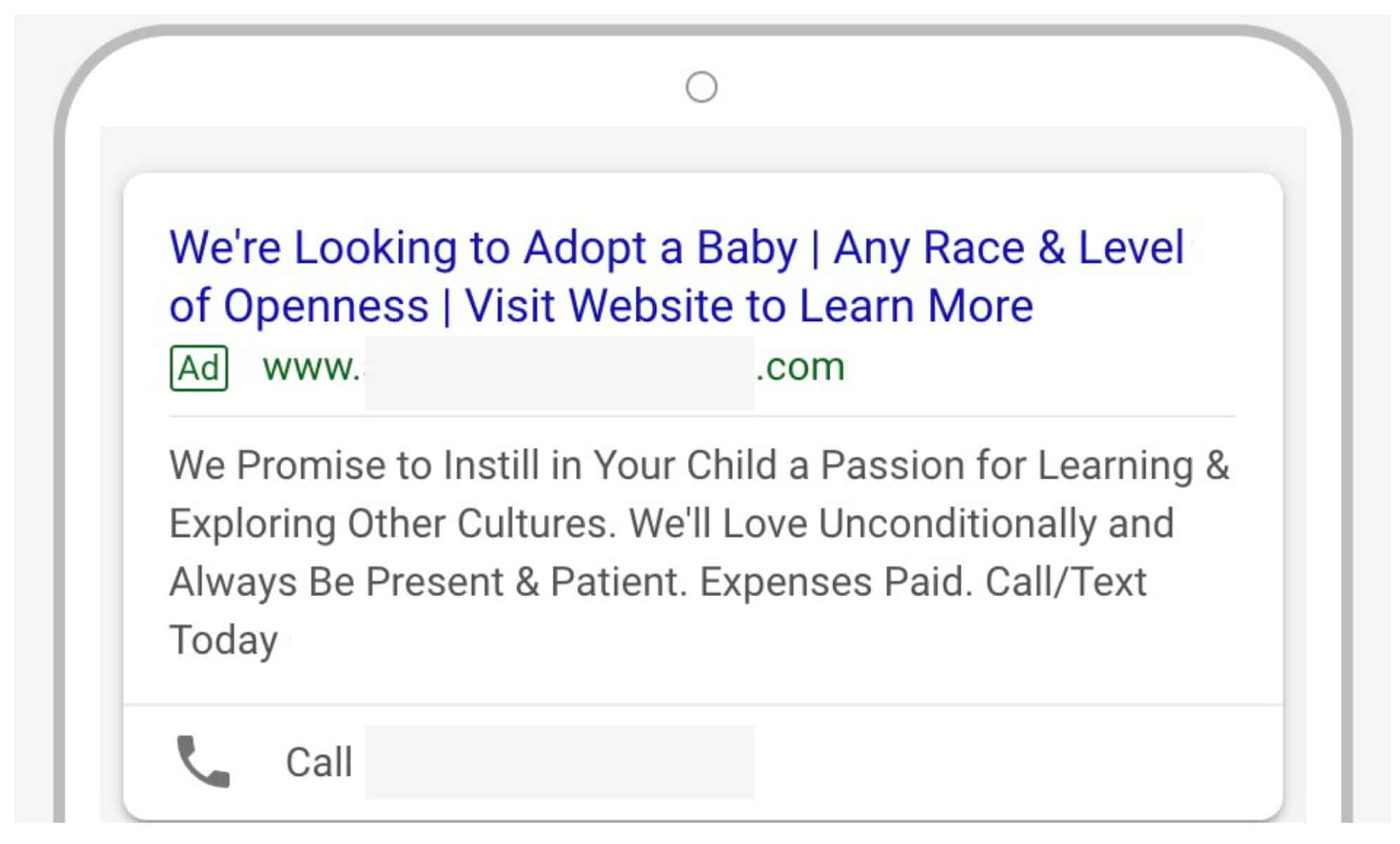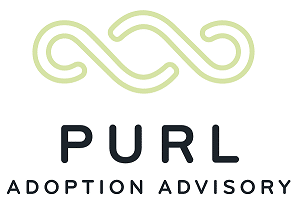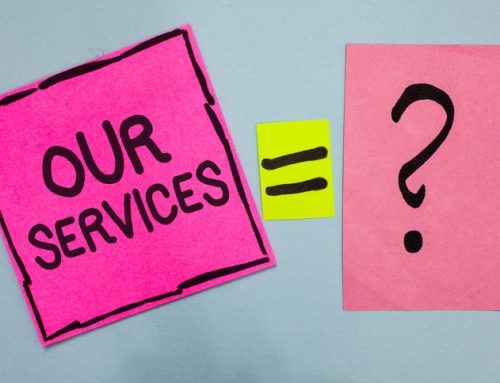
What if you could give your adoption profile to an expectant parent who is considering adoption at the exact moment she is asking herself, “How do I place my baby for adoption?” What if you could do this 40, 60, or even 80 times? Each month! This is what Google advertising offers adopting parents.
What is Google Ads?
Google Ads is an online advertising platform. It encompasses several different types of ad approaches, but for simplicity (and I believe they’re the best type for adopting parents), we’ll focus on pay-per-click, or PPC ads.
When you search for something using Google (or any search engine), the search engine returns the organic, or natural search results, but above and below those results are paid advertisements. Google identifies these ads with “Ad” next to them.
These are PPC ads. Google displays these ads for free, but when someone clicks on an ad, the searcher is sent to the advertiser’s website and the advertiser is charged for that click (hence the term, pay-per-click).
You’re probably already thinking: Who clicks on ads? Well, consider this: Google had $39 billion in revenue for the QUARTER ending in June 2019, and the vast majority of that revenue came from paid ads. So, I guess the answer is A LOT OF PEOPLE are clicking on these ads!
How Does it Work?
When you search for something on Google, there is basically an instantaneous, live auction that takes place. Advertisers target specific phrases and for each phrase, they establish the maximum dollar amount they are willing to pay for a click.
Google’s algorithm uses these maximum bids and a multitude of other factors to determine which ads it’s going to show and in which position on the page it’s going to show them. After someone clicks on an ad, Google may charge the advertiser a few cents, or even hundreds of dollars. The cost, in part, is determined by what advertisers are willing to pay.
If you were to advertise on Google to bring expectant parents considering adoption to your website, which phrase would you assign a higher maximum cost per click: “adoption” or “I want to place my baby for adoption?” Asked differently, which person do you think is more valuable to you, someone who searches for “adoption” or someone who searches for “I want to place my baby for adoption?”
I think your intuition is probably right. The answer is that you should be willing to pay a lot more to bring a someone to your website after they search for “I want to place my baby for adoption.” Someone who searches on “adoption” may be a expectant parent, too, but they may also be an adoptive parent, someone considering foster care or international adoption, someone looking to adopt a dog or cat or bunny, or someone looking into the adoption rate for the latest iPhone, for example. I don’t even include the keyword “adoption” in the campaigns I run. It’s not worth the cost, even if it’s only a few cents.
Someone searching on “I want to place my baby for adoption” is either an expectant parent, or someone who is reading this article and wants to see which ads show up. J (Please don’t click on adopting parents’ ads. They’ll be charged for those clicks. You can always copy/paste the link to their website to avoid them being charged.)
How Do You Know Who is Clicking on the Ads?
One of the things my adopting parent clients are (pleasantly) surprised about is that for the people who click on their ads, advertisers get to see the exact phrases those people used in their search. Did they search for “How do I adopt a greyhound dog?” If so, I would add “greyhound” and “dog” as negative keywords so their ads don’t show up when someone performs a search that includes those words. (Of course, those already exist in our lists, along with several hundred other negative keyword phrases.)
We know expectant parents are clicking on our clients’ ads because we can see that they are searching Google using phrases like, “I want to place my baby for adoption” and “Looking for someone to adopt my baby.”
Before anyone places a baby with you, matches with you, or even contacts you, these search phrases are your leading indicator that expectant parents are out there learning about you. It’s pretty exciting!
Any Downsides?
I’m going to be 100% straight with you. Like any other adoption professional out there, I would never say this works all of the time. It doesn’t. I also don’t know how long it’s going to take for you. The campaigns I manage for adopting parents definitely bring expectant parents to their websites, but I can’t make someone view the entire site, call my clients, or match or place a baby with them, of course.
Online advertising may also be an expensive approach. Some clicks cost $5, $10, or even $15 or more. That can add up to a lot of money over the course of many months. The flip side is that if the campaign brings the right person to your website quickly, this approach is actually much less expensive than other methods.
And finally, the people who reach out to you have obviously not been pre-“vetted” to ensure that they understand their rights, have had pregnancy counseling about their options, or are even pregnant. Always work closely with an adoption professional who can help you navigate these waters.
The Bottom Line
The 3 points above are important considerations, but go back to the title of this post, Google Ads: More Exposure = More Opportunities for Match. That’s true!
When it comes to success with domestic adoption, at a high level, your highest priority is to create an outstanding adoption profile. After that, it’s all about exposure – getting that profile in front of as many expectant parents considering adoption for their child as you can. The more exposure, the better, and that’s the promise of online advertising. Consider it if it feels right to you.
———

What if you could give your adoption profile to an expectant parent who is considering adoption at the exact moment she is asking herself, “How do I place my baby for adoption?” What if you could do this 40, 60, or even 80 times? Each month! This is what Google advertising offers adopting parents.
What is Google Ads?
Google Ads is an online advertising platform. It encompasses several different types of ad approaches, but for simplicity (and I believe they’re the best type for adopting parents), we’ll focus on pay-per-click, or PPC ads.
When you search for something using Google (or any search engine), the search engine returns the organic, or natural search results, but above and below those results are paid advertisements. Google identifies these ads with “Ad” next to them.
These are PPC ads. Google displays these ads for free, but when someone clicks on an ad, the searcher is sent to the advertiser’s website and the advertiser is charged for that click (hence the term, pay-per-click).
You’re probably already thinking: Who clicks on ads? Well, consider this: Google had $39 billion in revenue for the QUARTER ending in June 2019, and the vast majority of that revenue came from paid ads. So, I guess the answer is A LOT OF PEOPLE are clicking on these ads!
How Does it Work?
When you search for something on Google, there is basically an instantaneous, live auction that takes place. Advertisers target specific phrases and for each phrase, they establish the maximum dollar amount they are willing to pay for a click.
Google’s algorithm uses these maximum bids and a multitude of other factors to determine which ads it’s going to show and in which position on the page it’s going to show them. After someone clicks on an ad, Google may charge the advertiser a few cents, or even hundreds of dollars. The cost, in part, is determined by what advertisers are willing to pay.
If you were to advertise on Google to bring expectant parents considering adoption to your website, which phrase would you assign a higher maximum cost per click: “adoption” or “I want to place my baby for adoption?” Asked differently, which person do you think is more valuable to you, someone who searches for “adoption” or someone who searches for “I want to place my baby for adoption?”
I think your intuition is probably right. The answer is that you should be willing to pay a lot more to bring a someone to your website after they search for “I want to place my baby for adoption.” Someone who searches on “adoption” may be a expectant parent, too, but they may also be an adoptive parent, someone considering foster care or international adoption, someone looking to adopt a dog or cat or bunny, or someone looking into the adoption rate for the latest iPhone, for example. I don’t even include the keyword “adoption” in the campaigns I run. It’s not worth the cost, even if it’s only a few cents.
Someone searching on “I want to place my baby for adoption” is either an expectant parent, or someone who is reading this article and wants to see which ads show up. J (Please don’t click on adopting parents’ ads. They’ll be charged for those clicks. You can always copy/paste the link to their website to avoid them being charged.)
How Do You Know Who is Clicking on the Ads?
One of the things my adopting parent clients are (pleasantly) surprised about is that for the people who click on their ads, advertisers get to see the exact phrases those people used in their search. Did they search for “How do I adopt a greyhound dog?” If so, I would add “greyhound” and “dog” as negative keywords so their ads don’t show up when someone performs a search that includes those words. (Of course, those already exist in our lists, along with several hundred other negative keyword phrases.)
We know expectant parents are clicking on our clients’ ads because we can see that they are searching Google using phrases like, “I want to place my baby for adoption” and “Looking for someone to adopt my baby.”
Before anyone places a baby with you, matches with you, or even contacts you, these search phrases are your leading indicator that expectant parents are out there learning about you. It’s pretty exciting!
Any Downsides?
I’m going to be 100% straight with you. Like any other adoption professional out there, I would never say this works all of the time. It doesn’t. I also don’t know how long it’s going to take for you. The campaigns I manage for adopting parents definitely bring expectant parents to their websites, but I can’t make someone view the entire site, call my clients, or match or place a baby with them, of course.
Online advertising may also be an expensive approach. Some clicks cost $5, $10, or even $15 or more. That can add up to a lot of money over the course of many months. The flip side is that if the campaign brings the right person to your website quickly, this approach is actually much less expensive than other methods.
And finally, the people who reach out to you have obviously not been pre-“vetted” to ensure that they understand their rights, have had pregnancy counseling about their options, or are even pregnant. Always work closely with an adoption professional who can help you navigate these waters.
The Bottom Line
The 3 points above are important considerations, but go back to the title of this post, Google Ads: More Exposure = More Opportunities for Match. That’s true!
When it comes to success with domestic adoption, at a high level, your highest priority is to create an outstanding adoption profile. After that, it’s all about exposure – getting that profile in front of as many expectant parents considering adoption for their child as you can. The more exposure, the better, and that’s the promise of online advertising. Consider it if it feels right to you.
———




